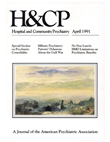Diagnosis of Physical Illness in Psychiatric Patients Using Axis III and a Standardized Medical History
Abstract
Psychiatrists' axis III diagnoses of physical illnesses in 357 psychiatric patients were compared with diagnoses by a physician's assistant using a standardized medical history form. The physician's assistant detected nearly three times as many physical illnesses as the psychiatrists. The psychiatrists were significantly more likely to miss diagnoses among older patients and women. Patients who met criteria for depressive disorders appeared to be at greatest risk for undetected illnesses, followed by patients with bipolar disorders and schizophrenia. Patients with a secondary diagnosis of substance abuse had significantly more undetected illness than those who did not abuse substances. The authors suggest that current axis III guidelines are inadequate and that a systematic review of physical health problems should be part of the psychiatric diagnostic assessment.
Access content
To read the fulltext, please use one of the options below to sign in or purchase access.- Personal login
- Institutional Login
- Sign in via OpenAthens
- Register for access
-
Please login/register if you wish to pair your device and check access availability.
Not a subscriber?
PsychiatryOnline subscription options offer access to the DSM-5 library, books, journals, CME, and patient resources. This all-in-one virtual library provides psychiatrists and mental health professionals with key resources for diagnosis, treatment, research, and professional development.
Need more help? PsychiatryOnline Customer Service may be reached by emailing [email protected] or by calling 800-368-5777 (in the U.S.) or 703-907-7322 (outside the U.S.).



